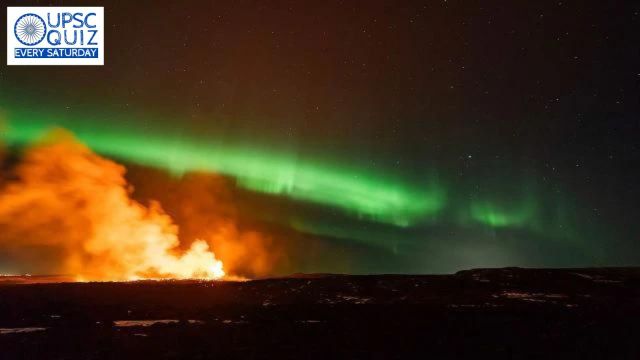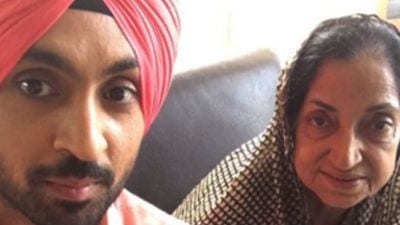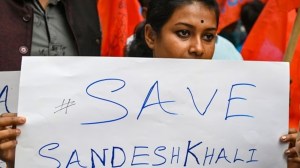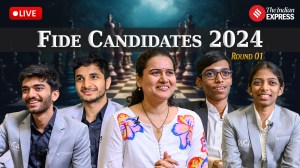- India
- International
UPSC Weekly Current Affairs Quiz | March 24 to March 30, 2024
Brush up your current affairs knowledge with this week's top 15 questions and consolidate your UPSC-CSE preparation. Find answers along with explanations at the end of the quiz.
 View of the eruption area with the northern lights dancing in the sky. Find a question on Reykjanes peninsula in today's quiz. (AP Photo)
View of the eruption area with the northern lights dancing in the sky. Find a question on Reykjanes peninsula in today's quiz. (AP Photo)UPSC Weekly Quiz is a current affairs-based quiz on relevant topics from the past week, curated for the aspirants of competitive examinations. Attempt the weekly quiz every Saturday and find answers to the MCQs with explanations at the end of the article.
🚨 The Indian Express UPSC Essentials brings to you the March edition of its monthly magazine. Click Here to read. Share your views and suggestions in the comment box or at manas.srivastava@indianexpress.com🚨
QUESTION 1
With reference to the Great Indian Bustard (GIB), consider the following statements:
1. It is listed as Critically Endangered.
2. These are mainly found in Desert National Park and Kutch region.
3. They are facing imminent extinction due to high-tension networks of solar and wind energy.
How many of the statements given above are correct?
(a) Only one
(b) Only two
(c) All three
(d) None
QUESTION 2
Dulung-Subansiri elephant corridor was recently in news. The corridor is located in:
(a) Manipur
(b) Sikkim
(c) Meghalaya
(d) Arunachal Pradesh

QUESTION 3
With reference to the H5N1, consider the following statements:
1. It is a highly pathogenic type of bird flu.
2. The infection has infiltrated mainland Antarctica.
3. The infection can be transmitted from person to person easily.
How many of the statements given above are correct?
(a) Only one
(b) Only two
(c) All three
(d) None
QUESTION 4
Consider the following statements:
1. Delisting of a monument is done by Archaeological Survey of India (ASI).
2. Once the monument is delisted, activities related to construction cannot be carried out.
Which of the statement(s) given above is/are correct?
(a) 1 only
(b) 2 only
(c) Both 1 and 2
(d) Neither 1 nor 2
QUESTION 5
The Government of India has signed the Memorandum of Understanding for financing arrangements for the GyalSung Infrastructure Project. The project is located in:
(a) Bhutan
(b) Nepal
(c) Vietnam
(d) Myanmar
QUESTION 6
Consider the following countries:
1. United States
2. India
3. China
4. Australia
5. Japan
How many of the above countries achieved soft-landing a spacecraft on the Moon?
(a) Only two
(b) Only three
(c) Only four
(d) All five
QUESTION 7
Reykjanes peninsula was recently in news due to eruption of a volcano. It is located in:
(a) Denmark
(b) Canada
(c) Russia
(d) Iceland
QUESTION 8
Consider the following:
1. Cost and time efficiency
2. Strengthen risk management
3. Settlement in 48 hours
4. Transparency in charges
How many of the above are the benefits of T+0 trading settlement cycle?
(a) Only one
(b) Only two
(c) Only three
(d) All four
QUESTION 9
With reference to the India TB Report 2024, consider the following statements:
1. The majority of the TB cases are reported by the private health centres.
2. The incidence of TB cases in 2023 decreased as compared to previous year.
3. Ni-kshay portal is used by government to track TB patients.
How many of the statements given above are correct?
(a) Only one
(b) Only two
(c) All three
(d) None
QUESTION 10
With reference to the Central Pollution Control Board (CPCB), consider the following statements:
1. It is the statutory pollution control body under the Union Environment Ministry.
2. It advises the Central Government on any matter concerning prevention and control of water and air pollution.
3. It provides technical assistance and guidance to the State Boards.
How many of the statements given above are correct?
(a) Only one
(b) Only two
(c) All three
(d) None
QUESTION 11
With reference to Total Fertility Rate (TFR), consider the following statements:
1. According to a Lancet report India’s TFR — will fall to 1.29 in 2050.
2. At 1.9, India’s TFR is currently just slightly above the replacement rate.
Which of the above statement(s) is/are correct?
(a) 1 only
(b) 2 only
(c) Both 1 and 2
(d) Neither 1 nor 2
QUESTION 12
With reference to Vaikom Satyagraha, consider the following statements:
1. In November 1936, the Maharaja of Travancore signed the historic Temple Entry Proclamation which removed the age-old ban on the entry of marginalised castes into the temples of the state.
2. The demonstration of Gandhian methods of civil disobedience as effective tools of protest, was the great success of the Vaikom Satyagraha.
Which of the above statement(s) is/are correct?
(a) 1 only
(b) 2 only
(c) Both 1 and 2
(d) Neither 1 nor 2
QUESTION 13
He was an Israeli-American psychologist who revolutionised the world with his experiments and insights — so much so that even though he was not an economist, he went on to win the Nobel prize in economics in 2002 “for having integrated insights from psychological research into economic science, especially concerning human judgment and decision-making under uncertainty”. He died on March 27 at the age of 90.
‘He’ refers to:
(a) Richard Thaler
(b) Daniel Kahneman
(c) Douglas Diamond
(d) Ragnar Frisch
QUESTION 14
Recently seen in news, Apple, Google, and Meta are being investigated for potential violations of the new Digital Markets Act. This Act belongs to:
(a) US
(b) Australia
(c) Russia
(d) None of the above
QUESTION 15
Which of the following pairs of countries have participated in ‘Tiger Triumph 2024′, a tri-services Amphibious Exercise recently seen in news?
(a) India and Japan
(b) Russia and China
(c) India and US
(d) US and UK
ANSWERS TO THE MCQs
1. (c)
FYI:
— The Supreme Court last week said it will review its April 2021 order to bury underground all power lines in the habitat of the Great Indian Bustard (GIB), after the Centre found the order “practically impossible to implement” over long distances.
— Great Indian Bustard Ardeotis nigriceps (hereafter GIB) is one of the rarest birds in world.
— It is listed as Critically Endangered and Schedule I (Wildlife (Protection) Act 1972). Hence, statement 1 is correct.
— The critically endangered GIB is trapped in a deadly tangle of power lines crisscrossing its final refuge in western India’s Kutch and Thar deserts. As these large, open landscapes hold the promise of abundant solar and wind energy, high-tension networks are evacuating power. Hence, statements 2 and 3 are correct.
Therefore, option (c) is the correct answer.
2. (d)
FYI:
— The wildlife division of the Union Ministry of Environment, Forest and Climate Change (MoEFCC) recently directed the forest departments of Arunachal Pradesh and Assam to prepare a proposal to notify the Dulung-Subansiri elephant corridor – downstream of the 2000 MW Lower Subansiri hydroelectric project.
— During the deliberations, members of the wildlife board concluded that this corridor is important, as it facilitates the east-west movement of elephants across the Subansiri River.
— They help animal movement and enable genetic exchange which in turn helps in sustaining elephant population.
Therefore, option (d) is the correct answer.
3. (b)
FYI:
— Since 2020, H5N1, a highly pathogenic strain of bird flu, has spread over the world, posing an existential threat to birds and biodiversity. Hence, statement 1 is correct.
— The virus has infected birds in over 80 nations (as of December 2023), resulting in the slaughter of millions of chickens and turkeys on commercial poultry farms.
— H5N1 is a type of influenza virus that causes a highly infectious, severe respiratory disease in birds called avian influenza (or “bird flu”)
— The virus does not infect humans easily, and spread from person to person appears to be unusual. Hence, statement 3 is not correct.
— The infection has also infiltrated mainland Antarctica for the time in history. Hence, statement 2 is correct.
Therefore, option (b) is the correct answer.
4. (a)
FYI:
— The Archaeological Survey of India (ASI) has decided to delist 18 “centrally protected monuments” because it has assessed that they do not have national importance. Hence, statement 1 is correct.
— Among the monuments that face delisting now are a medieval highway milestone recorded as Kos Minar No.13 at Mujessar village in Haryana, Barakhamba Cemetery in Delhi, Gunner Burkill’s tomb in Jhansi district, a cemetery at Gaughat in Lucknow, and the Telia Nala Buddhist ruins in Varanasi. The precise location of these monuments, or their current physical state, is not known.
— The ASI, which works under the Union Ministry of Culture, is responsible for protecting and maintaining certain specific monuments and archaeological sites that have been declared to be of national importance under the relevant provisions of The Ancient Monuments Preservation Act, 1904 and The Ancient Monuments and Archaeological Sites and Remains Act, 1958 (AMASR Act).
— Delisting a monument effectively means that it will no longer be conserved, safeguarded, or maintained by the ASI. The AMASR Act prohibits any type of development work near a protected site. Once the monument has been delisted, routine construction and urbanisation operations in the area can resume. Hence, statement 2 is not correct.
Therefore, option (a) is the correct answer.
5. (a)
FYI:
— The second tranche was handed over by India’s Ambassador to Bhutan Sudhakar Dalela to Bhutan’s Minister of Foreign Affairs and External Trade, Lyonpo D N Dhungyel.
— The Government of India has released a total of Rs 1,000 crore to the Government of Bhutan under the Memorandum of Understanding on the concessionary financing arrangements for the GyalSung Infrastructure Project.
Therefore, option (a) is the correct answer.
6. (c)
FYI:
— The Japan Aerospace Exploration Agency (JAXA) confirmed that its SLIM Moon lander survived two lunar nights without its instruments freezing.
—The Smart Lander for Investigating Moon launched in September last year and landed on the Moon on January 19.
— SLIM’s landing made Japan just the fifth country in the world to soft-land a spacecraft on the Moon after the United States, the Soviet Union, China and India.
Therefore, option (c) is the correct answer
7. (d)
FYI:
— A volcano spewing out lava in the backdrop of Northern lights. Volcano on the Reykjanes peninsula, which has erupted several times this year, even leading to a state of emergency being declared in southern Iceland in March.
— The Northern Lights, also known as aurora borealis, is caused by the interaction of the solar wind — a stream of charged particles escaping the Sun — and Earth’s magnetic field and atmosphere.
— These initial outbursts were short-lived, lasting only a few days each. However, a third eruption on February 8th, proved disruptive. The lava stream engulfed a vital pipeline, cutting off heat and hot water to thousands of residents.
— Iceland, a nation forged by fire and sitting atop a North Atlantic volcanic hotspot, is no stranger to eruptions. The island nation possesses vast experience in managing these natural events.
Therefore, option (d) is the correct answer.
8. (c)
FYI:
— In December last year, the capital markets regulator SEBI proposed to introduce a facility for clearing and settlement of funds and securities on T+0 (same day) on an optional basis, in addition to the existing T+1 settlement cycle.
— Under the T+0 trade cycle, the settlement of trades will happen on the same day after the closure of the T+0 market. If investors sell a share, they will get the money credited to their account the same day, and the buyer will also get the shares in their demat account on the very day of the transaction.
— A shortened settlement cycle will bring cost and time efficiency, transparency in charges to investors, and strengthen risk management at clearing corporations and the overall securities market ecosystem.
— The T+0 trade cycle is expected to provide flexibility in terms of faster pay-out of the funds against the securities to the sellers and faster pay-out of securities against the funds to the buyers. It will allow better control over funds and securities by the investors.
Therefore, option (c) is the correct answer.
9. (a)
FYI:
— The gap between the predicted number and actual cases of tuberculosis (TB) is shrinking, according to the India TB Report 2024, released by the Union Health Ministry.
— According to the report, the majority of the TB cases are still reported by the government health centres. Hence, statement 1 is not correct.
— The estimated incidence of TB in 2023 increased slightly to 27.8 lakh from the previous year’s estimate of 27.4 lakh. The mortality due to the infection remained the same at 3.2 lakh as per the data. Hence, statement 2 is not correct.
— The report shows that India reached its 2023 target of initiating treatment in 95% of patients diagnosed with the infection.
— This gap has been reducing over the years, especially with the government’s Ni-kshay portal tracking all TB patients. Hence, statement 3 is correct.
Therefore, option (a) is the correct answer.
10. (c)
FYI:
— According to a report given by the Central Pollution Control Board to the National Green Tribunal, up to 80% of the environment protection charge (EPC) and environmental compensation (EC) collected by the board stays unspent.
— CPCB is the statutory pollution control watchdog under the Union Environment Ministry. Hence, statement 1 is correct.
Functions of the Central Board at the National Level
— Advise the Central Government on any issues relating the prevention and control of water and air pollution, as well as the enhancement of air quality. Hence, statement 2 is correct.
— Plan and implement a national programme to avoid, control, or reduce water and air pollution.
— Coordinate the work of the State Board and handle disagreements between them;
— Provide technical help and guidance to the State Boards, conduct and sponsor investigations and research into water and air pollution problems, and their prevention, control, or abatement; Hence, statement 3 is correct.
— Plan and organise training of persons engaged in programme on the prevention, control or abatement of water and air pollution;
— Organise through mass media, a comprehensive mass awareness programme on the prevention, control or abatement of water and air pollution;
— Collect, compile and publish technical and statistical data relating to water and air pollution and the measures devised for their effective prevention, control or abatement;
— Prepare manuals, codes and guidelines for the treatment and disposal of sewage and trade effluents, as well as stack gas cleaning devices, stacks and ducts.
— Disseminate information on water and air pollution, including prevention and control measures.
— Establish, alter, or repeal stream or well standards in cooperation with the relevant state governments, as well as air quality criteria; and
— Perform any additional functions as directed by the Government of India.
Therefore, option (c) is the correct answer.
(Other Source: cpcb.nic.in)
11. (a)
FYI:
— India will turn into an ageing society in the next three decades, according to a report in the Lancet. The medical journal has flagged that India’s TFR — the average number of children born to a woman — will fall to 1.29 in 2050. One in five persons in India will be above the age of 60 in 2050. Hence, statement 1 is correct.
— At 1.9, India’s TFR is currently just below the replacement rate, and according to UNPF calculations, the share of the country’s working-age population will peak in the late 2030s, early 2040s. Hence, statement 2 is not correct.
Therefore, option (a) is correct answer.
12. (c)
FYI:
— Vaikom, a temple town in the princely state of Travancore, saw the start of a non-violent agitation on March 30, 1924 — the first among temple entry movements that would soon sweep across the country.
— The satyagraha foregrounded social reform amidst the growing nationalist movement, bringing Gandhian methods of protest to the state of Travancore.
Therefore, option (c) is the correct answer.
13. (b)
FYI:
— Daniel Kahneman’s contribution to economics has been in questioning the dominance of the assumption that all economic agents are rational.
— Through his experiments he underscored the flaws in such assumptions. In doing so, he helped establish behavioural economics as a field and many such as Richard Thaler (winner of the 2017 Nobel prize in economics and most commonly associated with his book “Nudge”) have further advanced the use of such psychological insights in economics.
Therefore, option (b) is the correct answer.
14. (d)
FYI:
— The European Union is investigating Apple, Google, and Meta for potential violations of the new Digital Markets Act, which aims to curb the power of big tech companies and create a more level playing field for smaller businesses.
Therefore, option (d) is the correct answer.
15. (c)
FYI:
— An Integrated Battalion Group from the Pune-headquartered Southern Command comprising various fighting elements including the Para Special Forces and crucial technological infusions including anti-drone systems is taking part in the second edition of tri-services India-US Amphibious Exercise ‘Tiger Triumph 2024’ along with Indian Navy and Indian Air Force.
Therefore, option (c) is the correct answer.
Subscribe to our UPSC newsletter and stay updated with the news cues from the past week.
Apr 04: Latest News
- 01
- 02
- 03
- 04
- 05





























